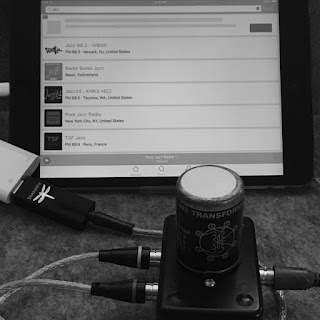|
However, due to the resurgence of interest in vinyl LPs and streaming, used CDs are available all over at bargain prices. Since I'm not committed to burning all my silver discs to a hard drive having had my own share of failures in the past, I was inspired to look into maximizing my CD playback system.  |
| Sony DVP-NS755V |
For the past 15 years, I relied mainly on this Sony DVD/SACD/CD player. It showed me that SACDs had an edge over CDs. Yet it proved that neither format was on equal footing with my LP set up. This is a polite sounding machine that also doesn't do anything great. Prior to the Sony, I owned an early bitstream (ca. '93) Philips CD921. It sounded sooo boring, I connected the digital out to an Audio Alchemy Dac In The Box to spice things up a bit until it (the CD921) prematurely died.
Nevertheless, I was still missing the lively sound of my first CD player, a Magnavox CDB472 I purchased in 1987. I had an inkling that the "bitstream" buzzword of the 90s was not an effort to improve sound quality but a watered down technology/marketing hype for manufacturers to maximize profits. Since I was more interested then (as now) in older technology, I placed digital audio tech aside, focused on learning how to build triode amps and high-efficiency speakers.
Nevertheless, I was still missing the lively sound of my first CD player, a Magnavox CDB472 I purchased in 1987. I had an inkling that the "bitstream" buzzword of the 90s was not an effort to improve sound quality but a watered down technology/marketing hype for manufacturers to maximize profits. Since I was more interested then (as now) in older technology, I placed digital audio tech aside, focused on learning how to build triode amps and high-efficiency speakers.
 |
| Denon DVD-2910 |
To re-acquaint myself with the few DVD-A titles I have, I acquired this reasonably priced Denon DVD-2910 multi-format compatible relic from the mid-2000s. It weighs almost 10 pounds, is built like a tank, is mechanically and functionally more refined compared to my entry-level Sony above due to higher quality materials (more metal). If this didn't sound better, it can serve as a CD transport for an external DAC. Fortunately SACDs did sound better, but not sure about CDs though...
Time Travel Machine
Ever since I embarked upon improving my internet streaming set up, I had to refresh and update my knowledge of Digital Audio, PCM, DSD, DACs, etc. It was inevitable that I'd encounter R2-R vs. delta-sigma debates in internet audio forums. I also discovered that there's a sub-culture of CD collectors/music lovers/DIYers (as opposed to meter readers/latest is best audiophiles) who maintain that the most musical sounding CD players are those 80s machines fitted with the more complicated and expensive-to-manufacture 16 bit Philips TDA1541 chip.
 |
| Under the hood of a CDB473 |
Out of retro-tech nostalgia, it was only fitting that I trace my steps back to my first CD player in ca.'87, the Magnavox CDB472, which used this ubiquitous chip. I did a bit better this time around with the higher model CDB473 which is equipped with a co-ax digital out, and can also be used as a CD transport. Considering that this unit celebrated its 30th birthday in December of 2017, it is a glowing testament to Philips' excellence in engineering and manufacturing that it still works today.
Let's see how the Magnavox's 16 bit DAC chip which was truly designed for Red Book CDs fares against the Delta-Sigma DAC chips found inside the Denon and Sony.
 |
| Magnavox CDB473 |
From the very first CD I fed into the tray, the Magnavox sounded more transparent and dynamic while the Denon and Sony sounded comparatively veiled and compressed. Even my wife heard its superiority. The CDB473 may not possess ultimate refinement but there's an honesty in its musical presentation that draws the listener into the music, just like analog LP does.
Truth be told, I don't remember the CDB472 sounding this good back in the 80s. But I had a totally different system then and was just beginning to wean myself off of the influence of underground audio journals of the era, which were largely pro-vinyl LP/anti-digital CD. I guess hindsight is indeed 20/20 with regards to the Philips TDA1541. I was too young to learn and appreciate its virtues. Besides, a year after this CDB473 was manufactured, Philips introduced bitstream technology, followed in the late 90s by Delta-Sigma, both claiming greater linearity. These were the technologies that dominated the market from the 90s to the present and also the sound I associated with the playback of 16-bit/44.1kHz mastered CDs.






























